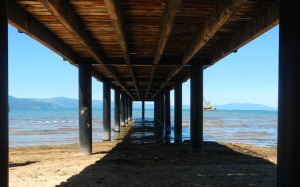Drought getting worse, expected to continue
By Associated Press
RENO — Forecasters say severe drought or worse will continue into next year across much of the West, including parts of western Utah, most of Nevada and practically all of California.
Below-normal precipitation and normal or above-normal temperatures are forecast in the week ahead, according to the National Weather Service, and experts say the three-year drought isn’t likely to be relieved in October, November and December.
In Reno, the Truckee River already is a trickle, flowing at its lowest level in two decades for this time of year. Officials say Lake Tahoe is close to dropping to its natural rim for the first time since October 2009.
As of Thursday, 81 percent of Nevada had severe drought conditions or worse. That was a slight improvement from the 87 percent in that category three months ago, but it was up from 78 percent the beginning of the year.
The U.S. Drought Monitor said that about half of Nevada reported extreme or exceptional drought last week — 36 percent extreme and 12 percent exceptional. Last January, extreme drought covered 23 percent of the state, with only 5 percent considered to be in the most extreme category of exceptional drought.
Half of Utah was reporting moderate drought and 16 percent severe drought. The most severe conditions were in the southwest and southeast corners of the state as well as a swath of western Utah stretching from near the Nevada line north of Interstate 80 southeast through Tooele and Juab counties to near Interstate 15.
There’s not much relief on the way, officials said.
Even in wet years, October and November don’t typically contribute much in terms of rain and snow in the region. December, however, is the start of the primary snow season in the Sierra, and the long-term forecast suggests a slight likelihood that month could trend dry as well.
“Even if December was wet, the drought wouldn’t be over yet,” said Zach Tolby, a meteorologist with the National Weather Service in Reno.
There’s a 65 percent chance of an El Niño developing this winter with warmer-than normal ocean temperatures that sometimes produces more precipitation than usual, Mr. Tolby said.
At Farad, Calif., just west of the Nevada line, Truckee River flows measured 104 cubic feet Thursday, compared with a normal 500 cubic feet per second for this time of year.
Most of the water now in the river consists of drought reserves coming from Donner Lake and owned by the Truckee Meadows Water Authority, said Chad Blanchard, federal water master.
Flows from the river’s largest reservoir, Lake Tahoe, are expected to halt altogether in late September when Tahoe drops below its natural rim 6,223 feet above sea level.
“We’re almost to the rim. We’ve only got a quarter-foot left,” Blanchard said. “We’re to the point that resource is going to be out for a while.”
The record low was on Nov. 30, 1992, when the lake dropped to 6,220.26 feet.




I remember when the lake got so low, the scientists claimed it would take many years for it to fill back to ‘normal’. It filled in one year.
Silly humans. Always trying to predict the future.
Dog: From this story it is rather difficult to infer that scientists thought it would take several years to fill. So unless you were referring to 1934, your memory is fuzzy. In reality, humans aren’t all that bad at predicting change.
http://articles.latimes.com/1991-01-23/local/me-517_1_lake-tahoe
Rick
Normal drought cycle. Just more scientists studying every nuance.
I’m with Dog, I too remember the water guys howling about doom and gloom back then. One good winter and it was over. Maybe not this time but I don’t need more quotes about how a wet December won’t end the drought. Yeah, yeah, we get it.
let’s all continue to reminisce with persons we have never met
I really want rain….A ton of rain. Imagine being able to paddle board down the creek that runs by near my house to the lake next summer.
try this video, it covers all of the denier BS
http://youtu.be/OWXoRSIxyIU